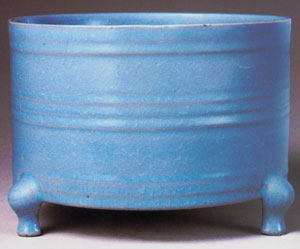The Song Dynasty (960-1279) witnessed booming development of Chinese porcelain making crafts, and porcelain making saw big achievements in terms of types, styles and firing techniques. Five kilns became outstanding during this period, namely Royal Kiln, Ding Kiln, Ru Kiln, Jun Kiln and Ge Kiln.
 |
| Song Dynasty, Vase, Royal Kiln |
Royal Kiln: It includes the Northern Song Royal Kiln and the Southern Song kiln. The South Song kiln site was at Hangzhou. Most of its products were bowls, plates, bottles and washing vessels, most of which had no decoration and had cracks. Moreover, there were products with thin body and thick glaze.
 |
| Song Dynasty, Pot with lotus pattern, Ding Kiln |
Ding Kiln: It originated in the late Tang Dynasty (618-907) and ended in the Yuan Dynasty (1271-1368). The main products of Ding Kiln in the Song Dynasty were white porcelain. In the mean time, green glaze, black glaze and brown glaze were also fired. Ding Kiln was famous for its beautiful, various decorative patterns. The plain, stamped vessels of Ding Kiln were always considered as a rarity of ceramic art.
 |
| Song Dynasty, Zun with three feet design, Ru Kiln |
Ru Kiln: The kiln site was at Linru county, Henan Province. The exact kiln site has not been found till now. Only porcelains were handed down. The main products Ru Kiln fired were court porcelain. Ru Kiln only existed for a short period, only twenty years. Therefore, of the famous kilns in the Song Dynasty, Ru Kiln has the least porcelains handed down.
 |
| Song Dynasty, Purple tray, Jun Kiln |
Jun Kiln: The kiln site was at Yuxian County, Henan Province. It was created in the Northern Song Dynasty (960-1127) and became popular in the late Northern Song Dynasty. Jun Kiln belongs to north celadon system. It featured flambé glaze. The glaze color was reddish celadon. The other feature was its glazed carves. Some royal appliance such as basin, tray and Zun (a kind of wine vessel used in ancient China) are all carved with numbers from 1 to 10.
 |
| Song Dynasty, Vase with two ears, Ge Kiln |
Ge Kiln: It was famous for the patterns. Most of its products were black, which can be divided into eel blood, blackish blue, fawn, net pattern, flower pattern, fine pattern etc. The feature of the cracks was: flat, tight and a little blue. Although there are a lot of porcelains of Ge Kiln handed down, the Ge Kiln sites still have not been found. This is one of the secrets of Chinese ceramic history.
